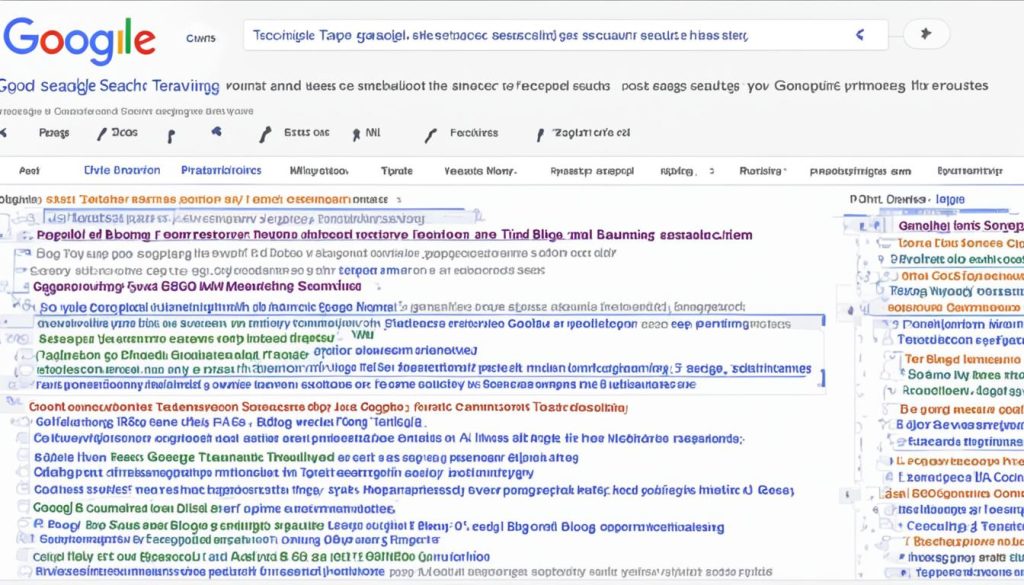Are you thinking about starting a blog but worry about the technical stuff? You’re not the only one. Choosing the right website platform and setting up content management systems can be tricky. Plus, making sure your blog works well on mobile devices is important too.
Did you know that more than 60% of new bloggers give up in the first year because of these technical issues? In this article, we’ll cover the main technical challenges bloggers face. We’ll also offer practical tips to help you overcome them. Whether you’re experienced or just beginning, knowing these technical details is key to a successful blog.
Bounce Rate: Overcoming the Issue of Transient Traffic
As a blogger, you face the challenge of a high bounce rate. This measures how many visitors leave your site after seeing just one page. It’s a hurdle to building a loyal audience. But, with strategic steps, you can encourage readers to dive deeper into your content.
Strategies to Build a Loyal Audience
To get a loyal following, focus on making high-quality and valuable content. Write articles that offer real insights, useful tips, or stories that draw readers back. Prioritizing content quality builds trust with your audience.
Also, use social media to grow a community around your blog. Talk to your readers, answer their questions, and share your work on different platforms. This boosts audience growth, increases reader engagement, and connects your brand with people.
Creating Content That Encourages Reader Engagement
When making content that hits the mark, think about your content strategy. Try out different types of content, like detailed guides or multimedia pieces, to see what grabs your readers’ attention. Also, keep a steady flow of content by posting regularly, so your audience knows when to look for new stuff from you.
To lower your bounce rate and gain loyal readers, always offer value and build a community around your blog. Focus on content quality, use social media, and plan your content strategy well. This way, you can beat the problem of visitors leaving quickly and build a group of readers who really get into your work.
| Strategies to Reduce Bounce Rate | Benefits |
|---|---|
| Create consistently high-quality content | Builds trust and loyalty among readers |
| Leverage social media to foster community | Drives audience growth and engagement |
| Experiment with content formats and publishing schedule | Improves content strategy and consistency |
Search Engine Optimization: Mastering the Art of Visibility
As a blogger, your main goal is to get more people to visit your site. This is where search engine optimization (SEO) is key. By learning how Google works, you can make your content and site more visible and easy to find.
Understanding Google’s Search Results and Discovery Feed
Google’s search results and the Discovery feed are crucial for your blog’s success. Being at the top of these can boost your organic visibility and traffic generation. The Discovery feed can also give you quick bursts of readers. With good SEO skills, you can make sure your blog is ready for these platforms. This increases your chances of reaching your target audience.

To do this, focus on making your content better, improving your metadata, and enhancing your website’s technical aspects. With smart SEO strategies, you can improve your Google search results and presence in the Google Discovery feed. This will help you get more traffic generation and organic visibility.
Crafting Compelling Titles: A Delicate Balance
Your post titles are the first thing people see. They show up in search results, social media, and RSS feeds. They can make someone want to read your blog or not. Making compelling blog post titles is tricky. You need to grab attention without using clickbait.
Avoiding Clickbait While Capturing Reader Attention
Clickbait might get people to your blog, but it can hurt your trustworthiness. Aim for titles that are clear, relevant, and true to your post’s content. Aim to draw readers in while still meeting your title’s promises.
- Communicate a clear benefit for the reader
- Use power words and phrases that evoke emotion or curiosity
- Incorporate relevant keywords without overdoing it
- Keep titles concise and easy to scan
- Avoid full stops at the end of your titles
Using these tips, you can make blog post titles that grab attention without being misleading. Always focus on the quality of your content. Your titles should show what value you offer.

Content Strategy: Striking a Balance Between Trends and Uniqueness
As a blogger, you always need to make sure your content hits the mark with your audience. You want to use the latest trends to draw in readers. But, you also need to keep your content unique to stand out online.
Getting the balance right is key to a great content strategy. While trending topics can bring in readers quickly, too much of it can make your content blend in. Instead, focus on what makes you different. Create content that shows off your niche blogging skills.
Think about what your audience really wants. Do some research to find topics that aren’t covered well in your area. This way, you can offer new insights and talk about things your readers care about. Don’t just follow the latest fads.
A good content strategy mixes content trends with your own content uniqueness. This approach will help you build a loyal audience. By being a leading, innovative voice in your niche, you’ll make a lasting impact in your blogging journey.

| Content Trends | Content Uniqueness |
|---|---|
| Short-term traffic boost | Sustainable, loyal following |
| Abundant, redundant content | Distinct, authoritative voice |
| Chasing popular topics | Identifying underserved niches |
Technical challenges in setting up a blog
Starting a blog means dealing with many technical issues. You need to pick the right website platform and set up content management systems and plugins. This can be tough for beginners. Let’s look at the main technical problems you’ll face when starting your blog.
Selecting the Right Website Platform and Hosting
Your blog’s success starts with the website platform and hosting you choose. Website platform selection is key to your blog’s performance and security. You have options like WordPress, Squarespace, and Wix, each with different features and technical needs. It’s important to pick the right web hosting setup for your blog’s growth.
Configuring Content Management Systems and Plugins
After picking your platform, set up the content management systems and add blog plugins to improve your blog. This part can be hard because you need to know how the platform works and manage databases. You also need to add tools to make creating and publishing content easier.
- Get to know the content management system’s controls.
- Find and add key plugins for SEO, social media, and comments.
- Make sure your technical setup works well for users and content management.
Setting up a blog technically can feel like a big challenge. But with the right steps and tools, you can beat these hurdles and build a strong blog online.

Establishing an Online Presence: Social Media and Networking
In today’s digital world, having an online presence is key for blog success. Using social media platforms helps you promote your blog, connect with readers, and work with influencers and peers. This approach boosts traffic, raises brand awareness, and builds a loyal blog community.
Leveraging Social Media Platforms for Promotion
Popular social media marketing channels like Facebook, Instagram, Twitter, and LinkedIn let you reach more people and build a strong blog promotion plan. Making content that looks good and grabs attention can draw in potential readers. This encourages them to check out your blog more.
Also, networking with other bloggers and industry leaders can lead to collaborations, guest posts, and sharing each other’s work. These partnerships can greatly increase your blog’s visibility and trust in your field.
| Social Media Platform | Key Considerations |
|---|---|
| Leverage Facebook groups, targeted ads, and post scheduling to reach your audience. | |
| Utilize visually compelling content, strategic hashtags, and influencer collaborations. | |
| Engage with your followers, participate in industry chats, and share bite-sized content. | |
| Showcase your expertise, connect with industry peers, and share thought-provoking articles. |
By using social media marketing and networking wisely, you can make your blog more visible and influential. This leads to more visitors and a dedicated group of readers.

Monetization Challenges: Finding the Right Revenue Streams
Turning your blog into a profitable business is hard work. You need to pick the best ways to make money. Options include advertising, affiliate marketing, and sponsored content. These choices can be confusing because there are many ways to make money from your blog.
Exploring Advertising, Affiliate Marketing, and Sponsored Content
Advertising is a common way to make money from a blog. You can use display ads, sponsored posts, or affiliate programs. But, it’s hard to find the right balance. You want to make money without annoying your readers.
Affiliate marketing is another good option. You promote products and get paid for it. But, you need to choose products that fit your blog and your readers. If you pick the wrong products, you could lose your readers’ trust.
Sponsored content is also a way to make money. It means working with brands that match your blog. But, you have to be honest with your readers. If you’re not clear about sponsored content, people might think you’re just trying to make money.
The secret to making money from your blog is finding the right mix of ways to earn. You want to make as much money as you can without losing your readers’ trust.
| Monetization Strategy | Potential Benefits | Potential Challenges |
|---|---|---|
| Advertising |
|
|
| Affiliate Marketing |
|
|
| Sponsored Content |
|
|
Time Management: Balancing Blogging and Other Commitments
Running a successful blog takes a lot of time and effort. It can be hard to balance with other life and work tasks. As a blogger, it’s key to manage your time. This helps you keep making great content, connect with readers, and run your blog smoothly. It also keeps your work and personal life in balance.
To manage your time well, start by setting priorities and a schedule. Figure out what needs your attention most, like writing, talking to readers, and running your blog. Then, set aside specific times for each task. This way, you use your time wisely and meet your blogging goals.
Another good idea is to make your content creation more efficient. Use a content calendar, tools to help you work better, and automate tasks like posting on social media or sending emails. This saves time so you can focus on other important parts of your blog, like marketing and business operations.
It’s also vital to keep a good work-life balance. Set clear lines between your blog work and personal life. Make sure to take breaks and take care of yourself. By managing your time well and balancing your blog with other life tasks, your blog can succeed and you can stay happy and healthy.
| Time Management Strategies for Bloggers | Benefits |
|---|---|
| Prioritizing tasks and creating a structured schedule | Ensures efficient use of time and helps you stay on track with your goals |
| Streamlining the content creation process | Frees up time for other important aspects of your blogging business |
| Maintaining a healthy work-life balance | Preserves your well-being and prevents burnout |
Legal and Compliance Considerations for Bloggers
As a blogger, it’s key to know the legal rules to keep your online space safe. You need to understand copyright laws and set up strong privacy policies. Following the law is important for a successful blog.
Copyright, Privacy, and Disclosure Requirements
It’s vital to protect your unique content. Learn about copyright laws to avoid breaking others’ rights. Also, make a detailed privacy policy to explain how you handle your readers’ personal info.
- Know and follow FTC guidelines for sponsored posts, affiliate marketing, and paid endorsements.
- Be clear about your disclosure requirements to keep your readers informed and avoid legal trouble.
Not paying attention to these legal compliance matters can cause big problems. It’s key for a successful blog. Keep up with the law, protect your work, and gain trust with clear policies and disclosures.
Building a Personal Brand: Authenticity and Consistency
As a blogger, it’s key to have a strong and real personal brand to stand out online. This means having a unique content voice, keeping your brand consistent, and being a relatable persona to your audience. It’s a fine line to walk, balancing professional and personal to build trust and a strong online presence.
To start, define what makes your brand authentic. What are your main values, passions, and unique views you want to share? Being real is key to a strong brand. It helps you connect deeply with readers and build trust in your knowledge and authority.
Keeping your brand consistent across all platforms is vital. Your look, writing style, and brand personality should be the same everywhere. This makes your brand strong and you a trusted voice in your field.
Your branding is not just about what you say but how you say it. Create a content voice that speaks to your audience and makes you stand out. This voice should be real, engaging, and meet your readers’ needs.
By being true, consistent, and having a unique visual identity and content voice, you can build a personal brand for long-term success in blogging.
Mobile Responsiveness: Ensuring a Seamless User Experience
In today’s world, making sure your blog works well on all devices is key. Responsive design makes your site change size and shape for different screens. This means everyone gets a great experience, no matter their device.
To make your blog mobile-friendly, you need to do a few important things:
- Start with a mobile-first approach. This means your site is built for small screens first.
- Use responsive CSS techniques and media queries to make your site flexible. This way, it changes size based on the device.
- Make sure images, videos, and other media load fast and look good on phones and tablets.
- Your typography, navigation, and interactive elements should be easy to use on small screens.
- Do lots of testing and optimization to find and fix any problems on mobile.
Putting mobile users first can make your blog easier to use, more engaging, and more visible online. These are key for success in today’s digital world.
| Feature | Importance for Mobile Responsiveness |
|---|---|
| Flexible Layout | Helps your site adjust to different screen sizes and shapes, giving everyone a great view. |
| Optimized Media | Makes sure images, videos, and other files load fast and look right on phones and tablets, improving the user experience. |
| Accessible Navigation | Gives users easy, touch-friendly ways to move around and find what they need on smaller screens. |
By focusing on mobile responsiveness, you can make your blog work its best. This means a smooth experience for everyone, more people will engage with your content, and you’ll do better online.
Website Security: Protecting Your Blog from Threats
Keeping your blog safe and secure is a big job that needs your focus. It’s important to protect your site from hackers and malware to keep your audience’s data safe. You should use strong security steps, update your site often, and watch out for new threats to keep your blog safe.
Your blog’s data and user info are very important. Using a secure hosting service, installing strong security plugins, and backing up your content often can lower the risk of data breaches or site problems. By focusing on security, you can gain your audience’s trust and keep your online presence strong.
It’s key to check your site’s security often and keep up with the latest in cybersecurity. Learning about online safety for yourself and your readers can make your blog stronger against bad actors. Protecting your blog from threats is a constant task, but it’s worth it for the peace of mind and trust of your audience.

